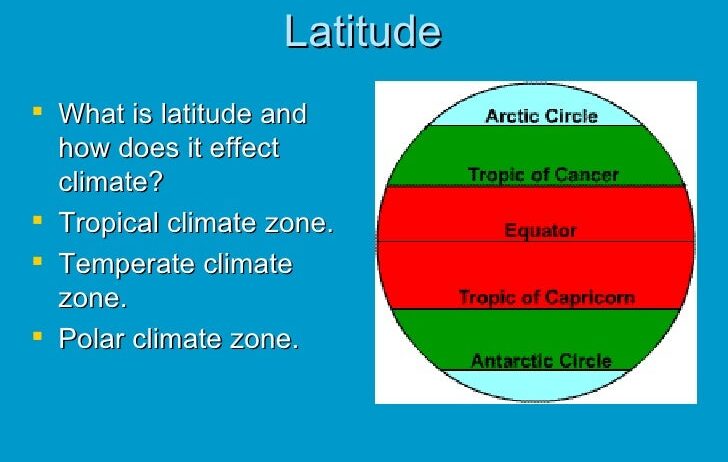Latitude, a fundamental geographic parameter, plays a pivotal role in shaping the climate across the globe. While it is often said that the equator is synonymous with warmth and tropical delights, the reality is far more nuanced. A critical exploration of how latitude influences climate reveals patterns and contradictions that provoke a reconsideration of our preconceived notions. It begs the question: does latitude solely dictate the heat, or is there a more intricate tapestry woven into our planet’s climatic systems?
At the heart of the issue lies the fundamental principle of solar radiation. The Earth is a sphere, and its curvature leads to uneven heating from the Sun. Areas near the equator receive sunlight at a more direct angle throughout the year, resulting in higher temperatures. Conversely, poles receive sunlight at a more oblique angle, leading to colder conditions. This is not merely about warmth; it forms the baseline of distinct climatic regimes. However, to reductively associate latitude with temperature is to oversimplify a complex interplay of factors that define climate.
As one moves away from the equator, factors such as altitude, ocean currents, and prevailing wind patterns become increasingly influential. For instance, the Andes mountains in South America, despite lying close to the equator, showcase a variety of climates ranging from tropical at the base to glacial at their peaks. This dichotomy highlights the necessity to consider elevation in tandem with latitude. Thus, it can produce cold climates in places that would otherwise be expected to be warm simply due to their location.
The complexity continues with the influence of ocean currents. These massive flows of water redistribute heat across the globe, showcasing how maritime geography further complicates the narrative. Take the Gulf Stream, for example. Originating in the tropics, this current travels northward, bringing milder temperatures to countries such as Britain and Norway. It effaces the notion that latitude alone governs climate, illuminating the significance of oceanic influences. Countries situated at higher latitudes, benefiting from warm ocean currents, may well enjoy a temperate climate, despite being positioned far from the equatorial belt.
Furthermore, prevailing winds and atmospheric circulation patterns contribute significantly to climatic conditions. The Hadley Cell, a pattern of atmospheric circulation, transports warm air away from the equator toward the poles. As this air cools, moisture condenses, precipitating in the tropics while leaving arid conditions in subtropical regions. This results in desert climates in latitudinal bands, demonstrating that climate extends beyond mere temperature differentials and into the realm of meteorological dynamics.
It is essential also to consider seasonal variations. The tilt of the Earth’s axis causes different latitudes to experience changes in solar exposure throughout the year. This axial tilt leads to the creation of seasons. As such, while areas near the equator maintain relatively uniform temperatures year-round, higher latitudes encounter significant variations between summer and winter. It is a cycle, a dance between the Earth’s rotation and revolution around the Sun, continually affecting climatic conditions independently of latitude.
Moreover, human-induced climate change introduces additional layers of complexity. As greenhouse gases accumulate in the atmosphere, they bring about shifts in weather patterns, potentially altering the expected climatic outcomes of a given latitude. Areas that were once temperate may experience hotter conditions, while those near the poles could find their ice caps melting at alarming rates, reshaping the climate landscape. It serves as a poignant reminder of our interconnectedness with these systems, challenging us to reconsider how we engage with our environment.
Nevertheless, the concept of climatic regions linked to latitude remains valid. The Köppen climate classification system, one of the most widely used climatological tools, relies heavily on latitude to categorize the Earth’s myriad climates. However, this system must be employed with caution; it illustrates regions that are climatically similar rather than pinpointing singular climatic behaviors within latitudinal belts. The intricate interplay between latitude, geography, and climatic factors necessitates a multi-dimensional view to truly appreciate our planet’s climatic narrative.
Returning to the equator, it is indeed a region of abundant biodiversity and lush rainforests, yet it hosts climate zones that reflect a variety of ecological niches. For instance, the Amazon rainforest, a quintessential equatorial biome, demonstrates that factors such as precipitation, humidity, and even soil composition are vital to understanding its climate. This reality rings true across the globe, revealing a truth that transcends simple geographic metrics. Each region tells its climate story, intricately woven through myriad influences and interactions.
Therefore, it is imperative to promote a holistic understanding of climate that transcends latitude as a solitary determinant. As climate change accelerates, our comprehension of these diverse interactions will become increasingly crucial—a shift in perspective that not only fosters curiosity but also encourages robust discussions on environmental stewardship. The inquiry into whether latitude affects climate, while critical, should serve as a catalyst for deeper explorations of the myriad components influencing our world. In doing so, we nurture a more thoughtful and responsible relationship with our planet, adjusting our actions, policies, and attitudes toward a more sustainable future.
In conclusion, latitude matters, yet it is only one piece of the larger climatic puzzle. Understanding the nuances of how and why climate varies across the globe will deepen our appreciation for the remarkable complexity of our environment. By asking ourselves what lies beyond the equator’s heat, we can embrace a narrative that is richer, more complex, and undeniably vital for our collective future.







